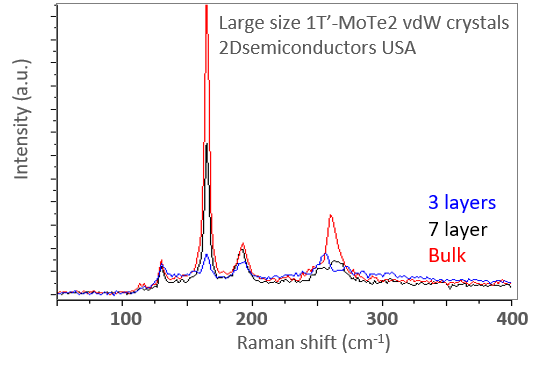1T' metallic phase of MoTe2 crystals contain layers that are stacked together via van der Waals interactions and can be exfoliated into thin 2D layers. Our large size 1T'-MoTe2 vdW crystals are treated as gold standards in 2D materials field. They come with guaranteed environmental stability, negligible amount of point defects, highly metallic response, and high carrier mobility. Our MoTe2 crystals are synthesized two different methods (flux zone and chemical vapor transport). While flux zone provides extremely clean MoTe2 crystals, CVT method often introduces halide contaminants. For comparison between these tow methods, please see the information below.
Characteristics of 1T'-MoTe2 crystals from 2Dsemiconductors USA

Growth method matters> Flux zone or CVT growth method? Contamination of halides and point defects in layered crystals are well known cause for their reduced electronic mobility, reduced anisotropic response, poor e-h recombination, low-PL emission, and lower optical absorption. Flux zone technique is a halide free technique used for synthesizing truly semiconductor grade vdW crystals. This method distinguishes itself from chemical vapor transport (CVT) technique in the following regard: CVT is a quick (~2 weeks) growth method but exhibits poor crystalline quality and the defect concentration reaches to 1E11 to 1E12 cm-2 range. In contrast, flux method takes long (~3 months) growth time, but ensures slow crystallization for perfect atomic structuring, and impurity free crystal growth with defect concentration as low as 1E9 - 1E10 cm-2. During check out just state which type of growth process is preferred. Unless otherwise stated, 2Dsemiconductors ships Flux zone crystals as a default choice.




联系人:严春伟
手机:13914543285
电话:0523-86190619,86192878
邮箱:taizhou@sunano.com.cn
地址: 江苏省泰州市凤凰西路168号